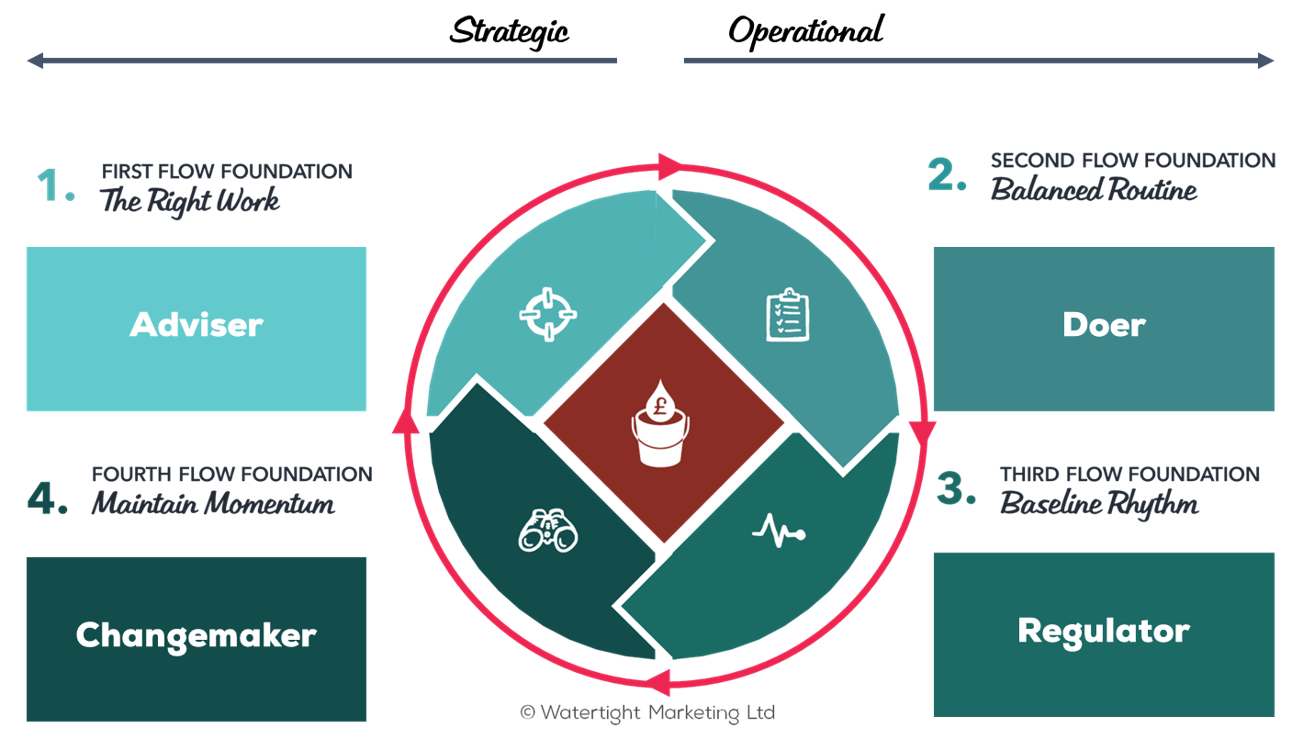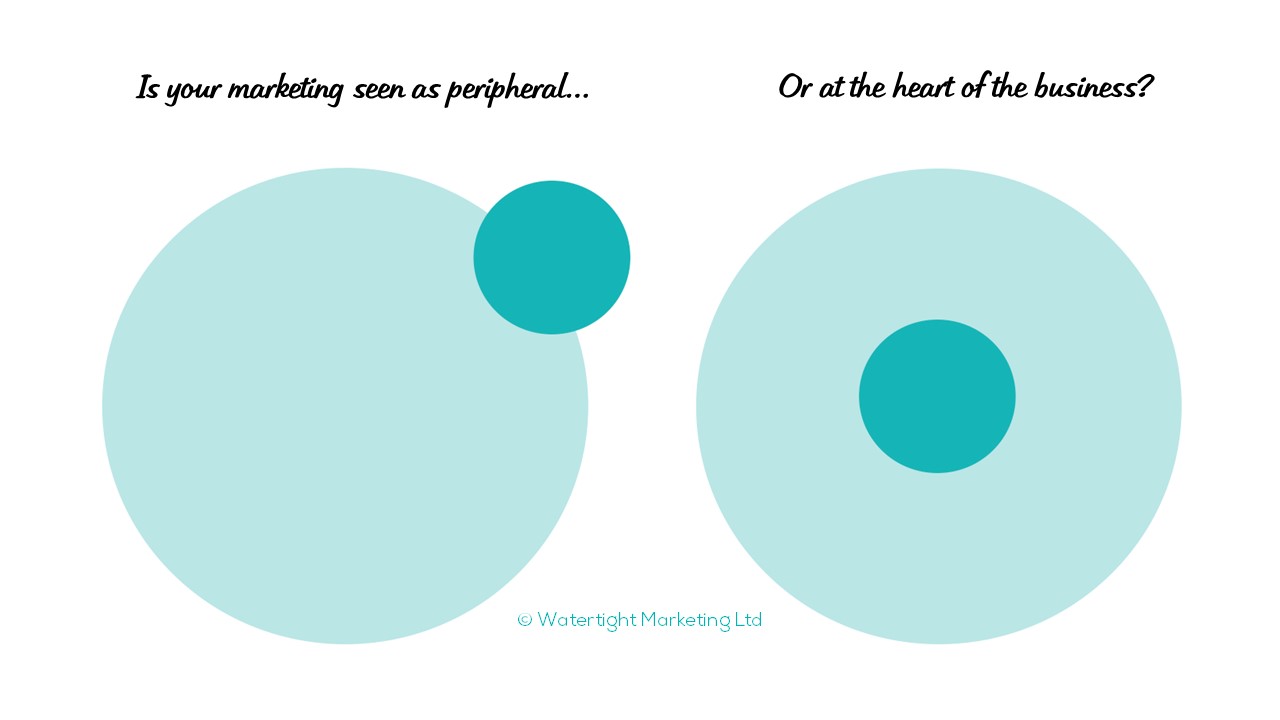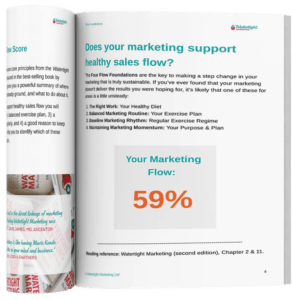Reading Time: 10 Minutes
“How you’re positioned in your business is critical to your success. If your boss and colleagues don’t rate marketing in general, it’s an uphill struggle to prove yourself, whatever your experience and knowledge. So, what’s the answer? In this roundtable we chatted about how to build your credibility within the business and what the success factors are.” ~ Rachael Wheatley, Managing Director | Watertight Business Thinking
Listen to the session podcast here
56-minute roundtable discussion on building your credibility within the business.
We kicked off the roundtable with a question, asking attendees what words or phrases came to mind that would demonstrate credibility:
Collaborative and transparent
Successful
Delivers
Strategic and planned – not reactive
Speaking in business language
People listen to your ideas
Keeping it simple
This is a picture of what credible marketing looks like for marketers. This is what you’re aiming for.
The marketing hat you’re wearing changes what credibility looks like
Rachael started by exploring the four hats a marketer might wear – each one relating to one of the Flow Foundations. Two on the strategic side and two on the operational side. Each hat characterises a role that needs to be performed for that Foundation to work well. Of course, real life is usually not quite so simple; most marketers wear more than one hat.

Changemaker: This person challenges the status quo, leads the charge on change, innovates. They have the difficult conversations. They are willing to have a view and voice their opinion and can back it up. They make sure the vision and values are more than skin deep and woven into the fabric of sales, marketing and customer service.
Adviser: The adviser listens, reflects and provides clear opinion and advice. They are consultative, collaborative, sound others out, get different perspectives and garner data to come to a well-rounded view or decision. They need to work closely with other teams in the business as well as seeking out customers to find out what they’re thinking and feeling.
Doer: This is the person who gets stuff done. They like crossing things off their list and thrive on being effective and efficient. They have a plan, work methodically, conscientiously and support others to ensure their work is completed. Good communicators, they work well both internally and externally, and manage all strands of marketing, picking the right tools and weaving everything to work seamlessly together.
Regulator: Thrives on process and monitoring. They love the data and want to delve into it to see what it’s saying and showing. They make sure the plan goes to plan, identify and create the right processes, guidelines and manage people, money and time resources. They’ll keep things on track – budget, plans, activities, suppliers, metrics – and help to overcome any challenges in these areas.
Credibility at the highest level is about your experience and knowledge, showing the courses you’ve done or accreditations you’ve achieved and that you’re learning is on-going. Credibility is demonstrated by your ability to build trust, your professionalism, integrity and authenticity. Asking good questions is an excellent way of showing you know what you’re talking about.
Whichever role is yours in the business, the initial period in a new company can be make or break. How are you introduced to the business, how are you positioned? What does that first 90 days entail? Make sure you’re set up to success and can start building good relationships from the start.
Credibility applies differently to each role:
Changemaker: Experience at Board level helps but if you don’t have it you’re looking to your boss and others to be supportive of the fact that you’re learning. Being able to take people with you, recognising that people need time to change and need their concerns addressed. Adept at standing your ground without it being a battle – but humble enough to know when you need to flex or change. Things that kill credibility for changemakers includes talking jargon or looking for quick wins at the expense of a long-term focus.
Adviser: All about building trust and being truly collaborative. Prove your credibility by knowing lots about the customer and their viewpoint, by knowing about the product or service you sell and why people buy it. Credibility killers include: if you feel marketing is only your dominion without recognising that everyone plays a part or forgetting to engage internally with colleagues as well as externally with customers.
Doer: Credibility is shown by getting stuff done and being highly effective and efficient. That’s not to say you don’t push back if you feel that what you’re being asked to do isn’t the right thing. As long as you explain why and chat it through, this can actually enhance your credibility. Excellent communication and recognising this is a two-way process. Organised, knowledgeable but not too proud to say need to go to a specialist. Credibility killers include being trapped as the colouring-in department, allowing perfect to get in the way of momentum or burning through tactics and not leaving long enough to evaluate.
Regulator: Prove credibility through data, meaningful analysis and metrics plus a consistently executed plan. Working with other team members, key to credibility is helping to prove the ROI of marketing because they’re the ones that lead on metrics and budgets. Things that kill credibility include: meaningless metrics or presenting a shopping list for a budget rather than linking it to a clear plan that helps to achieve targets.
Of course, if you wear more than one hat, building credibility is a lot more complicated!
Dan Bond: “There’s no better way to establish credibility than to achieve the things you need to achieve. I was having a conversation with our CEO about this topic, we were talking about raising investment. At the end of the day, we both came to the conclusion that the things that get you through investment is having a successful business, getting new customers and being profitable. And it’s the same in marketing. If you’re successful, you’re driving the outcomes you’re supposed to drive, and they’re not always commercial.”
Rachael Wheatley: “And of course, depending on the business you work for, that can take time so you need to manage expectations. There are quick wins, but often it takes months or a year for that success to come through.”
David Pearson: “A lot of our clientele are public sector and very risk averse. So when we talk about credibility what helps immensely is that we’ve worked with similar organisations with similar needs. Other things come into play such as qualifications but it’s experience that is key.”
Rachael Wheatley: “That raises the question of how you prove credibility if you haven’t had the experience?”
David Pearson: “In that scenario you have to be creative and ask yourself where you have done something similar, whether it’s the product, the client, their needs or something else. A classic example of this where we’ve entered the private sector world and needing to demonstrate credibility having worked in the public sector. Because we targeted who we go to, we could say we worked in similar sectors and so the transfer was easier by focusing on the cross-over experience.”
The importance of context

If marketing is seen as peripheral, it’s a much harder environment in which to prove credibility. It will take time and you’ll need allies. Part of the task is therefore to bring marketing front and central, over time. When building the credibility of the function you’re looking to professionalise it.
Things we’ve seen work here include:
- Training and coaching run across the business. Even starting from the basics (“what is marketing?”) can help and on-going learning for the marketing team is essential.
- Work towards team alignment (marketing, sales and service) by running joint or cross-team projects or workshop sessions working on a common problem. This gives others a really good sense of what you know and do.
- Leading the marketing, being involved end to end not just in charge of tactical. What you’re looking to do here is build relationships with the leadership team or board and contribute to strategic and wider business issues.
The relationship with your boss is key. As with context, the right relationship enables you to do your best work and therefore build your credibility.
Having an ally, communicating and managing expectations really help
David Pearson: “If you have a great network of allies who can vouch for you, even if they’re from a different world, that does help; they can talk about where you’ve delivered for them, completed a project or done some things successfully.”
Kerry Turney: “It can be difficult to build credibility in a business that doesn’t value marketing. And I agree that a good relationship with your boss is important. My boss gives me a lot of freedom and has a lot of faith in me. He also knows I will make mistakes – but that’s ok because you test and learn and can improve what you’re doing.”
Amy Leddington: “My CEO is extremely supportive. Credibility internally is also important, as you said, and managing people’s expectations. When you’re new in role, some people expect instant change and results, monitoring things like social media. I’m way off that because I’m working on an audit first. Early communication internally has been really important to manage expectations and let people know what I’m doing and why.
“There is a bit of a magpie mentality here with people coming up with ideas. I’m finding it hard to manage but suggesting we go back to basics first and build on that.”
Rachael Wheatley: “Magpie marketing is one of the marketing credibility killers because there isn’t the thinking or planning behind it that will make it effective – you’re just pursuing the latest idea or shiny thing. Pushing back helps to build your credibility.”
Amy Leddington: “Yes, I agree. I am going for some quick wins to satisfy their keenness to do things without undermining the more strategic work I’m doing at the moment.”
Simon Swan: “A step back from this is organisational culture. Everyone has an opinion. And lots of people come up with ideas which may – or often may not be – the right activity. To drive change you need to have someone in the C-suite who is prepared to back you. As long as you provide clear direction on what you’re doing and why you’re doing it.”
Head of Marketing: “Getting an ally is difficult in my business. They’ve been told by a non-executive director that they need me, but they don’t know why. So I’ve needed to look externally for support.”
How wearing more than one hat affects your credibility
Balancing the different hats seemed to be key here.
Maggie Mutkovicova: “One thing I was reflecting on when you were going through those four roles is how many of us probably embody all four of them. It can really affect credibility if you don’t have that balance right.
“I’m a year and a bit into my role in a small cybersecurity consultancy and now trying to be more strict with myself and others. I’ve got to know the business enough that I can pull together a “we will” and “we won’t” do list. That really helps. And if you communicate it well, it helps with that magpie mentality. If you come with this idea, does it fit in with the strategic goals we have for this year? If not, I’ll keep it in mind. I think that can really help with credibility and show that you can maintain a balance between strategic thinking and executing and doing.”
Head of Marketing: “I’m working in a business where I wear all the hats. Balancing the strategy and doing. I have had a win, though, in that we’re going to have a new website. It will hopefully be a springboard to elevate the brand and they’ll see something tangible.”
Rachael Wheatley: “It’s worth mapping out what those quicker wins in different roles might be to help you build a little credibility bit by bit across the board.”
Amy Leddington: “In a previous organisation I’ve been in a marketing and operations role where the marketing was 5% of it. There were a lot of historical issues to sort out before I could get to the marketing. I had to be persistent to bring it back on the agenda and increase the amount of time I was spending on marketing.”
Context and alignment are key
Simon Swan: “A lot of it is a diagnosis of the culture and the ways of progression. Is success about climbing the corporate ladder or do they invite new ways of working, identifying those gaps and opportunities? Culture is not often talked about as it relates to marketing. You can be the best marketer, but if you can’t get the organisational buy-in and influence and can’t work at all levels from C-suite to the most junior person, you’re not going to get anywhere.”
Rachael Wheatley: “Really interesting point. We’ve had a session before on the influence of context or competence. Our conclusion was that unless the context allows you to thrive, even the best marketers won’t thrive. Is it possible to be credible if marketing is at the periphery of the business?”
See: What matters most to effective marketing, context or competence?
Simon Swan: “One of the things I’ve done in the past is run marketing academies. To get credibility supercharged, make sure what you’re doing is connected right back to why the business exists. Is it to make sales, drive leads, grow reach. Because if you don’t make that connection, you’re going to lose credibility. The C-suite themselves are probably accountable for driving sales, growing market share, etc. The learning academy also makes that connection – how marketing drives sales, grows leads or market share. Where I’ve seen success is having learning sessions asking people how you can help them, how you can bridge gaps between departments and bringing external people in to share information about different industries.
“You need to be persistent. It takes time to change and for people to see the role of marketing and how it can support them. And suddenly you have brilliant case studies of breaking down internal silos.”
Rachael Wheatley: “Working with people, for instance on joint projects, helps to demonstrate to them that you can help them achieve their objectives. It helps build credibility, shows what you know and how you approach things.”
Maggie Mutkovicova: “At a previous employer, a lot of the friction of whether marketing is worth its money came from the fact that the business strategy and the marketing strategy were not aligned at all. It made me think that in terms of demonstrating credibility, a lot of the time it’s about asking the right questions, getting to the bottom of what marketing needs to do to support the business’s aims. If you can have those conversations to make the link, that’s the really big win.”
Rachael Wheatley: “That point links to a diagnosis early in your tenure of what’s working and what’s not. The marketing strategy not linking to the business plan could be a part of that, or highlighting key things that need to done.”
Dan Bond: “Never be afraid to walk away from a job if you think it’s not right or you think the business isn’t doing enough to solve the problems it has that would enable them to get the value from marketing. Do think about the kind of organisation you want to work for, look at those leading, and assess whether you can make an impact.”
Watertight Wisdom
What’s worked for us
Eight nuggets from around the room:
-
- Communication. Let people know what you’re doing and why.
- Managing expectations. Of the quick wins as well as the successes that might take longer. Of the ideas that link directly to a plan and those that might be a “no” or “not yet”.
- Balance the strategic and operational. Since it’s common for marketers to have more than one role, usually one that straddles the thinking and doing, it’s important to balance the strategic and operational so you can do both and show a least a little credibility in each of the four roles.
- Stand your ground. Ask the right questions and push back if need be.
- Use a strategic project to build credibility. It’s a great way to drive change, involve people from different teams and get your voice heard around the business.
- Map out strategic projects. So there’s always another on the horizon that you can use to facilitate cross-team working and build on your credibility.
- Align business with marketing. Facilitate the development of business plans if you need to, but clearly link marketing with business objectives.
- Have an ally. To drive change and to be successful you need an ally in the business. If that’s not possible seek a mentor or support externally.
What would you add to our list? Do let us know your thoughts.
To join the conversation at our next Watertight Wednesday marketing roundtable in May sign up here. We’ll be having a chin-wag about how to show impact through quick wins and long-term success. What quick wins can you show? What successes are longer term and what milestones can you put in place that will show progress?
Do come along and share your experience with others and tap into ideas from the room about how to achieve success.

Rachael Wheatley
Managing Director, Watertight Thinking
Rachael brings over 30 years’ of marketing experience, with a particular focus on building and developing effective marketing teams that are able to act as a strategic driving force across an organisation. She has worked with Watertight since 2014 as a Master Practitioner and joined the business as MD in 2022.



